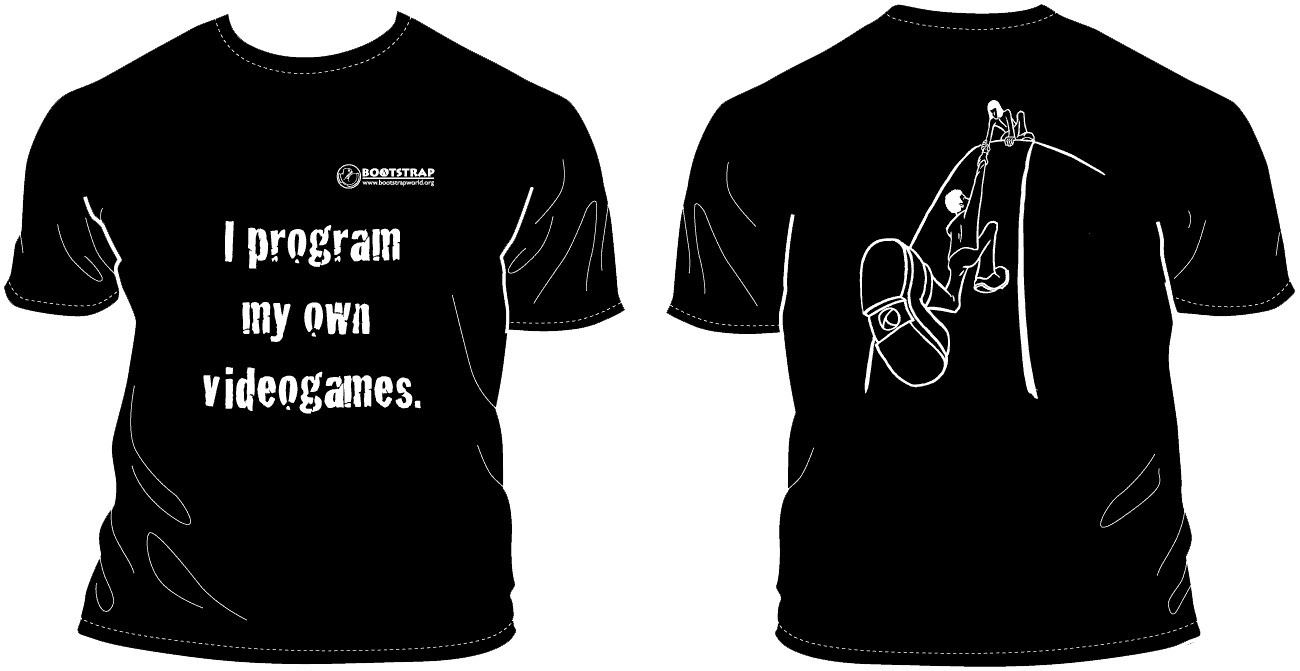
Materials
This file is out of date - did you arrive here by following an old bookmark? We keep these pages up for historical purposes but you can always access the current version of our materials by clicking on the
materials link in the sidebar.
If you're a math teacher, and are looking for a fun way for students to practice and apply what they've learned, or a programming teacher who is looking for a rigorous introduction to basic functions and datatypes, you'll find Bootstrap:1 to be a perfect fit! All of our lessons are aligned to Common Core Standards for Mathematics -- including the new standards for Mathematical Practice!
If you're looking for a full-blown programming class, and want students to have the freedom to create more advanced games using data structures, events, and more, you'll want to continue to the second module (Bootstrap:2) to build on what students have done in the introductory course. We've listed the breakdown of concepts in the table below - take a look to find the best fit for you!
| Mathematics | Programming |
|
Starting with Bootstrap:1...
Students create a simple, 3-character game involving a player, a target and a danger. They design what each character looks like, and use algebraic concepts to detect collisions, handle keystrokes, and determine how they move and interact.
|
- Word Problems
- Coordinate planes
- Order of Operations
- Variables
- Functions
- Function Tables
- Domain and Range
- Function Composition
- Inequalities
- Piecewise Functions
- Pythagorean Theorem
- Number lines
- Polygons
|
- Numbers, Strings and Images
- Defining Functions
- Unit Testing
- Boolean Logic
- Multi-input Functions
- Mixed-Type Functions
|
|
Continuing to Bootstrap:2...
Students learn how the world-based event loop that drives their Bootstrap 1 game works, and use it to create animations using simple datatypes for their world. They then learn about data structures, and design a World structure for a sophisticated game of their own design.
|
- Complex functional relationships
- Exploring Randomness
- Connections to Trigonometry
|
- Event-Driven Programming
- Data Structures
- Whole-Program Design
- Data Modeling
- Encapsulation
- Connections to recursion, lists, and algorithms
|

After Bootstrap...
If you've completed the entire Bootstrap curriculum, you'll be happy to know that your class can move on to advanced material, without needing to learn a new language! Here are just a few of the options available to Bootstrap teachers:
- Picturing Programs focuses heavily on images and animation, as students explore recursion, lists, trees and algorithms -- all using the same language and Design Recipe they've learned in Bootstrap.
- How to Design Programs is a textbook aimed at more college-level audiences, going beyond the material covered in Picturing Programs. HtDP is currently in its second edition, and the material is being actively updated.

Software
Bootstrap uses
WeScheme, a cloud-based IDE that requires
no downloading or installation. Anyone with a Gmail account can start developing with WeScheme, storing and retrieving files from the cloud and doing all of their editing in a modern browser. Additionally, WeScheme programs can be shared simply by sending out a link, or posting it to sites such as Facebook, Reddit, Twitter, etc.
Want to run everything locally? Bootstrap also supports
DrRacket, a multi-platform graphical environment. DrRacket runs on all major platforms (Windows, OS X, Unix/Linux) and programs written for one platform run seamlessly on the others, supporting a wide variety of classroom and home computing scenarios. Its emphasis on beginner-friendly features and support for images makes it ideal for Bootstrap.

Wear It
You've got the curriculum,
but do you own the t-shirt?
Show the world your support for Bootstrap, and let people know that yes,
"I
Program My Own Videogames". All t-shirts are high-quality cotton,
available in sizes ranging from S to XXL, for a price of $15 each for orders
of 1-5 shirts or $10 for larger orders (cost includes shipping).
Contact us to place an order.
Front and Back:






